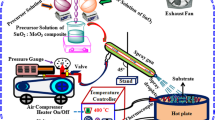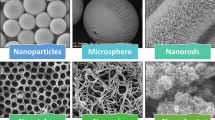Abstract
The effect of hexamethylenetetramine (HMT) concentration while keeping zinc nitrate [Zn(NO3)2] at constant concentration and vice versa on the morphology, optical absorption, structure of ZnO nanostructure and the performance of the DSSC utilizing the ZnO samples has been investigated. The ZnO photoanode samples were deposited on FTO substrate via hydrothermal growth at 90 °C for 8 h followed by cooling at 50 °C for 16 h. It was found that the structure and morphology of ZnO nanostructure are significantly influenced by the molar ratio of precursor concentration. The high density and smaller diameter of ZnO nanorods were formed when molar ratio of OH− ion concentration was increased. The modification on the shape and porosity of ZnO nanostructure are seemingly influenced by the amount of free ion Zn+2 in the growth solution. The samples have been utilized as photoanode in DSSC. The DSSC utilizing ZnO nanosheets performs the J SC, V OC, FF and η of 3.6 mA cm−2, 0.50 V, 0.31 and 0.56 %, respectively. The highest performance of that cell is due to the high density and unique morphology of ZnO nanosheets that offered high specific surface area for higher dye loading and light harvesting.













Similar content being viewed by others
References
S. Mathew, A. Yella, P. Gao, R. Humbry-Baker, B.F.E. Curchod, N. Ashari-Astani, I. Tayernelli, U. Rothlisberger, M.K. Nazeeruddin, M. Gratzel, Dye-sensitized solar cell with 13 % efficiency achieved through the molecular engineering of porphyrin sensitizers. Nat. Chem. 6, 242–247 (2014)
K. Mahmood, H.J. Sung, A dye-sensitized solar cell based on a boron-doped ZnO (BZO) film with double light-scattering-layers structured photoanode. J. Mater. Chem. A 2, 5008–5417 (2014)
M. Mc-Cune, W. Zhang, Y. Deng, High efficiency dye-sensitized solar cell based on three dimensional multilayered ZnO nanowire arrays with “caterpillar-like”. Nano Lett. 12, 3656–3662 (2012)
H.-L. Hsu, C.-F. Tien, Y.-T. Yang, J. Leu, Dye-sensitized solar cells based on gel electrolytes using allymidazolium iodides and environmentally benign solvent. Electrochim. Acta 19, 208–213 (2013)
Z.Z. Zhou, Y. Ding, X. Zu, Y.L. Deng, ZnO spheres and nanorods formation: their dependence on agitation in solution synthesis. J. Nanopart. Res. 13(2011), 1689–1696 (2011)
R.S. Kumar, R. Sathyamoorthy, P. Matheswaran, P. Sudhagar, Y.S. Kang, Growth of novel ZnO nanostructure by soft chemical route. J. Alloys Compd. 506, 351–355 (2010)
T. Tan, Y. Li, Y. Liu, B. Wang, X.M. Song, E. Li, H. Wang, H. Yan, Two-step preparation of Ag/tetrapod-like ZnO with photocatalytic activity by thermal evaporation and sputtering. Mater. Chem. Phys. 111, 305–308 (2008)
B. Baxter, E.S. Aydil, Nanowire-based dye-sensitized solar cell. Appl. Phys. Lett. 8, 053114-3 (2005)
Y.F. Hsu, Y.Y. Xi, C.T. Yip, A.B. Djurišić, W.K. Chan, Dye-sensitized solar cell using ZnO tetrapod. J. Appl. Phys. 103, 083114-4 (2008)
B.J. Baxter, E.S. Aydil, Dye-sensitized solar cells based on semiconductor morphologies with ZnO nanowires. Solar Energy Mater. Solar Cells 90, 607–622 (2006)
A.A. Umar, S. Nafisah, S.K.M. Saad, S.T. Tan, A. Balough, M.M. Salleh, M. Oyama, Poriferous microtablet of anatase TiO2 growth on an ITO surface for high-efficiency dye-sensitized solar cells. Solar Energy Mater. Solar Cells 122, 174–182 (2014)
M. Saito, S. Fujihara, Large photocurrent generation in dye-sensitized ZnO solar cells. Energy Environ. Sci. 1, 280–283 (2008)
S. Rani, P. Suri, P. Shishodia, R.M. Mehra, Synthesis of nanocrystalline ZnO powder via sol–gel route for dye-sensitized solar cells. Solar Energy Mater. Solar Cells 92, 1639–1645 (2008)
Q. Zhang, T.P. Chou, B. Russo, S.A. Jenekhe, G. Caou, Agreggation of ZnO nanocrystalline for high conversion efficiency in dye-sensitized solar cell. Electrochem. Commun. 47, 2402–2406 (2008)
N. Memarian, I. Concina, A. Braga, S.M. Rozati, A. Vomiero, G. Sberveglieri, Hierarchically assembled ZnO nanocrystallites for high-efficiency dye-sensitized solar cells. Angew. Chem. Int. Ed. 50, 12321–12325 (2011)
S.A.M. Samsuri, M.Y.A. Rahman, A.A. Umar, M.M. Salleh, Synthesis and characterization of TiO2–ZnO core-shell nanograss hetero-structure for dye-sensitized solar cell. J. Mater. Sci. Mater. Electron. 26, 4936–4943 (2015)
U. Ozgur, Y. Alivov, C. Liu, A. Teke, M.A. Reshchikov, S. Dogan, V. Avrutin, S.J. Cho, H. Morkoc, A comprehensive review of ZnO materials and devices. J. Appl. Phys. 98, 041301-1–041301-103 (2005)
A.A. Umar, M.Y.A. Rahman, R. Taslim, M.M. Salleh, M. Oyama, Effect of the thickness of quasi one-dimensional zinc oxide nanorods synthesized via multiple growth process under ammonia assisted hydrolysis technique on the performance of dye-sensitized solar cell. Int. J. Electrochem. Sci. 7, 8384–8393 (2012)
D.C. Look, Recent advances in ZnO materials and devices. Mater. Sci. Eng., B 80, 383–387 (2001)
A. Sugunan, H. Warad, M. Boman, J. Dutta, Zinc oxide nanowires in chemical bath on seeded substrates: role of hexamine. J. Sol-Gel Sci. Technol. 39, 49–56 (2006)
L. Roza, M.Y.A. Rahman, A.A. Umar, M.M. Salleh, Direct growth of oriented ZnO nanotubes by self-selective etching at lower temperature for photo-electrochemical (PEC) solar cell application. J. Alloys Compd. 618, 153–158 (2015)
L. Vayssieres, N. Beerman, S.-E. Lindquist, A. Hagfeldt, Controlled aqueous chemical growth of oriented three-dimensional crystalline nanorods arrays: application to iron (III) oxides. Chem. Mater. 13, 233–235 (2001)
A.A. Umar, M.Y.A. Rahman, R. Taslim, M.M. Salleh, Dye-sensitized solar cell utilizing quasi one-dimensional of highly compact vertical array ZnO nanorods. Int. J. Electrochem. Sci. 7, 7253–7260 (2012)
M.Y.A. Rahman, M.M. Salleh, I.A. Talib, M. Yahaya, Effect of surface roughness of TiO2 films on short-circuit current density of photoelectrochemical cell of ITO/TiO2/PVC-LiClO4/graphite. Curr. Appl. Phys. 5, 599–602 (2005)
M.Y.A. Rahman, A.A. Umar, L. Roza, M.M. Salleh, Effect of optical property of surfactant treated TiO2 nanostructure on the performance of TiO2 photoelectrochemical cell. J. Sol. State Electrochem. 16(2012), 2005–2010 (2012)
R. Rusdi, A. Rahman, N.S. Mohamed, N. Kamarudin, N. Kamarulzaman, Preparation and band gap energies of ZnO nanotubes, nanorods and spherical nanostructures. Powder Tech. 210, 18–22 (2011)
C. Wang, B. Mao, E. Wang, Z. Kang, C. Tian, Solution synthesis of ZnO nanotubes via a template-free hydrothermal route. Solid State Commun. 141, 620–623 (2007)
D. Polsangkram, P. Chamninok, S. Pukird, L. Chow, O. Lupan, G. Chai, H. Khallaf, S. Park, A. Schulte, Effect of synthesis conditions on the growth of ZnO nanorods via hydrothermal methods. Phys. B 403, 3713–3717 (2008)
A. Sacco, A. Lamberti, R. Gazia, S. Bianco, D. Manfredi, N. Shahzad, F. Cappelluti, S. Ma, E. Tresso, High efficiency dye-sensitized solar cells exploiting sponge-like ZnO nanostructures. Phys. Chem. Chem. Phys. 14, 16203–16208 (2012)
C.-H. Lin, Y.-H. Lai, H.-W. Chen, J.-G. Chen, C.-W. Kung, R. Vittal, K.-C. Ho, Highly efficient dye-sensitized solar cell with a ZnO nanosheet-based photoanode. Energy Environ. Sci. 4, 3448–3455 (2011)
M.Y.A. Rahman, A.A. Umar, R. Taslim, M.M. Salleh, Effect of organic dye, the concentration and dipping time of the organic dye N719 on the photovoltaic performance of dye-sensitized ZnO solar cell prepared by ammonia-assisted hydrolysistechnique. Electrochim. Acta 88, 639–643 (2013)
M.S. Akhtar, M.A. Khan, M.S. Jeon, O.-B. Yang, Controlled synthesis of various ZnO nanostructured materials by capping agents-assisted hydrothermal method for dye-sensitized solar cells. Electrochim. Acta 53, 7869–7874 (2008)
M.Y.A. Rahman, A.A. Umar, R. Taslim, L. Roza, S.K.M. Saad, M.M. Salleh, TiO2 and ZnO thin film nanostructure for photoelectrochemical cell application a brief review. Int. J. Electroact. Mater. 2, 4–7 (2014)
Acknowledgments
This work was supported by the Ministry of Higher Education of Malaysia under research Grant FRGS/2/2013/SG02/UKM/02/8, FRGS/2/2013/SG02/UKM/02/5 and GUP-2013-030.
Author information
Authors and Affiliations
Corresponding authors
Ethics declarations
Conflict of interest
The authors declare that there is no conflict of interests regarding the publication of this paper.
Rights and permissions
About this article
Cite this article
Roza, L., Fairuzy, K.A.J., Dewanta, P. et al. Effect of molar ratio of zinc nitrate: hexamethylenetetramine on the properties of ZnO thin film nanotubes and nanorods and the performance of dye-sensitized solar cell (DSSC). J Mater Sci: Mater Electron 26, 7955–7966 (2015). https://doi.org/10.1007/s10854-015-3449-6
Received:
Accepted:
Published:
Issue Date:
DOI: https://doi.org/10.1007/s10854-015-3449-6




